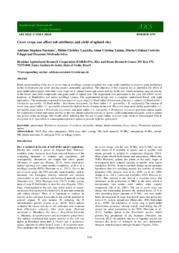Cover crops can affect soil attributes and yield of upland rice.
Cover crops can affect soil attributes and yield of upland rice.
Author(s): NASCENTE, A. S.; LACERDA, M. C.; LANNA, A. C.; FILIPPI, M. C. C. de; SILVA, D. M.
Summary: Better understanding of the use of cover crops at no-tillage systems in upland rice crop could contribute to increase grain production in this environment and allow moving toward sustainable agriculture. The objective of this research was to determine the effect of pearl millet intercropped with other cover crops on N mineral forms and urease activity in the soil, nitrate reductase enzyme activity in the leaves and yield components and grain yield of upland rice. The experiment was performed in the year 2012/2013 in two locations, in Haplorthox soil under no-tillage system. The experimental design was a complete randomized block with eight replications. The treatments consisted of four types of cover crop [(1) Pearl millet (Pennisetum glaucum) - control; (2) Pearl millet + Crotalaria spectabilis; (3) Pearl millet + Brachiaria ruziziensis; (4) Pearl millet + C. spectabilis + B. ruziziensis]. The mixture of cover crops pearl millet + C. spectabilis allowed the highest levels of nitrate in the soil. The cover crops pearl millet, pearl millet + C. spectabilis, pearl millet + Brachiaria ruziziensis, and pearl millet + C. spectabilis + Brachiaria ruziziensis provided similar results for ammonium content and urease activity in the soil, nitrate reductase activity in leaves, yield components and grain yield of upland rice grown under no-tillage. Our results allow inferring that the use of pearl millet, as cover crop, alone or intercropped with B. ruziziensis or C. spectabilis is a management practice option to provide high rice grain yield.
Publication year: 2016
Types of publication: Journal article
Unit: Embrapa Rice & Beans
Observation
Some of Embrapa's publications are published as ePub files. To read them, use or download one of the following free software options to your computer or mobile device. Android: Google Play Books; IOS: iBooks; Windows and Linux: Calibre.
Access other publications
Access the Agricultural Research Database (BDPA) to consult Embrapa's full library collection and records.
Visit Embrapa Bookstore to purchase books and other publications sold by Embrapa.

